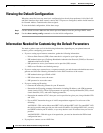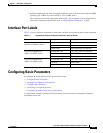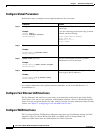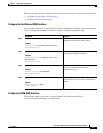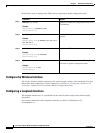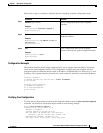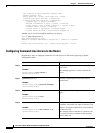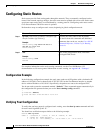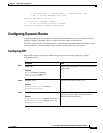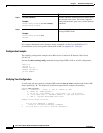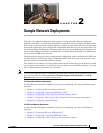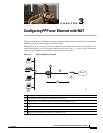
1-10
Cisco Secure Router 520 Series Software Configuration Guide
OL-14210-01
Chapter 1 Basic Router Configuration
Configuring Static Routes
Configuring Static Routes
Static routes provide fixed routing paths through the network. They are manually configured on the
router. If the network topology changes, the static route must be updated with a new route. Static routes
are private routes unless they are redistributed by a routing protocol. Configuring static routes on the
Cisco Secure Router 520 Series router is optional.
Perform these steps to configure static routes, beginning in global configuration mode:
For complete information on the static routing commands, see the Cisco IOS Release 12.3
documentation set. For more general information on static routing, see
Appendix B, “Concepts.”
Configuration Example
In the following configuration example, the static route sends out all IP packets with a destination IP
address of 192.168.1.0 and a subnet mask of 255.255.255.0 on the Fast Ethernet interface to another
device with an IP address of 10.10.10.2. Specifically, the packets are sent to the configured PVC.
You do not need to enter the commands marked “(default).” These commands appear automatically in
the configuration file generated when you use the show running-config command.
!
ip classless (default)
ip route 192.168.1.0 255.255.255.0 10.10.10.2
!
Verifying Your Configuration
To verify that you have properly configured static routing, enter the show ip route command and look
for static routes signified by the “S.”
You should see verification output similar to the following example.
Router# show ip route
Codes: C - connected, S - static, R - RIP, M - mobile, B - BGP
D - EIGRP, EX - EIGRP external,
i - IS-IS, su - IS-IS summary, L1 - IS-IS level-1, L2 - IS-IS level-2
Command Purpose
Step 1
ip route prefix mask {ip-address | interface-type
interface-number [ip-address]}
Example:
Router(config)# ip route 192.168.0.0
255.255.0.0 10.10.10.2
Router(config)#
Specifies the static route for the IP packets.
For details about this command and additional
parameters that can be set, see the
Cisco IOS IP
Command Reference, Volume 2 of 4: Routing
Protocols.
Step 2
end
Example:
Router(config)# end
Router#
Exits router configuration mode, and enters
privileged EXEC mode.



